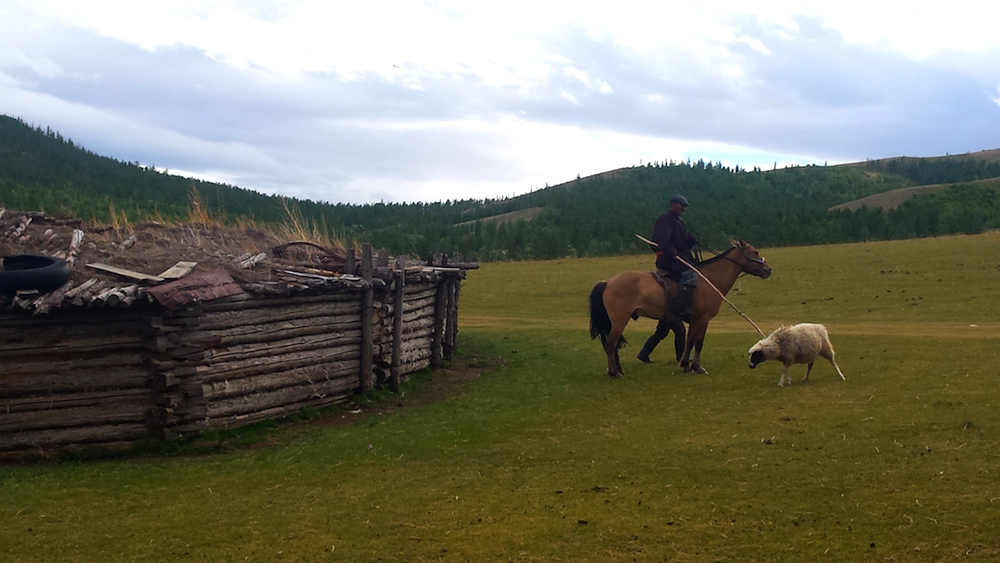“Cooperation is about preparation:” Preliminary results from the HGP’s Mongolia field site
By Thomas Conte
The Human Generosity Project
September 28, 2015
Mongolia’s 21st century nomadic herders are merging a centuries-old economic tradition with post-2000 tech savvy. Roughly 30% of Mongolia’s population of 2.84 million make their living by migrating each season with herds of horses, goats, sheep, camels, and cattle. This mobile lifestyle often prompts folks in the West to imagine romantic ideas of what it would be like to live in the culture of wandering warriors who conquered most of Eurasia under the leadership of Chinghis Khan and his grandsons. But in 2015 Mongolia, you’re far more likely to see nomadic herders chatting on their iPhones or watching the latest soap opera on satellite TV than you are to see them contemplating the next invasion!
While Mongolian nomads are living in a 21st century world, their nomadic herding tradition is alive and well, and most families make at least four seasonal migrations to new pastures each year. These migrations help ensure that pastures are given a chance to rest and re-grow after livestock graze them.
Most herders agree that being a nomad is a hard, but wonderful life. It is about balancing hard work and harsh weather conditions (temperatures drop as low as minus 50˚F in the winter!) with the joys of watching your family’s herd grow and living in a beautiful steppe environment.
The goal of my preliminary trip to Mongolia in May-June 2015 was to explore labor sharing and systems of mutual aid among Mongolian herders living in central Mongolia’s Bulgan Province. In this region, herding depends greatly on families’ willingness to work together to manage livestock and make a good living from herding. Yet, while many herders speak proudly about Mongolians’ strong ideals of generosity and hospitality, it is unclear how the dynamics of labor sharing and mutual aid play out in the harsh realities of life on the steppes.
Herders in Bulgan are particularly concerned with preparing for periodic natural disasters that affect Mongolia known as dzud. Dzud often come in the form of severe winter storms that weaken livestock and make them unable to access grass under thick layers of snow and ice. These disasters can have serious effects on herders’ livelihoods and often cause widespread livestock mortality. For example, in the winter of 2009-2010, Mongolia experienced such a severe disaster that nearly 10 million head of livestock died (roughly 20% of the national livestock herd).
Asking herders about their perceptions of dzud and who they would turn to in order to manage disasters is a tricky and taboo subject that herders are often uncomfortable speaking about. Interview questions about dzud must always be prefaced with “I’m sorry to have to ask you this, and I would never wish this to happen to you or your family…” Asking a herder what he or she would do if his or her family lost all of their livestock in a dzud is the equivalent of asking what Americans would do if their houses burned down, they went bankrupt, and they were diagnosed with a terminal illness all at the same time!
When assured that my questions were all purely hypothetical, and that I didn’t wish any harm to anyone’s family or herd, most herders agreed that the key to managing winter dzud is to prepare adequate winter shelters for livestock and to cut enough hay to feed livestock through the winter.
Most herders agreed that cooperation and labor sharing mostly occur as herders prepare for the winter. This preparation involves many labor intensive tasks that individual families (especially those without an adequate supply of laborers) would have difficulty doing on their own. These activities include cutting and storing hay for the winter, repairing winter livestock shelters and making them more windproof, and administering vaccines and veterinary care to animals. Very few families I spoke to believed that herders can do much for one another once a climatic disaster actually occurs.
One herder asserted “I would love to help other families living in my area if a dzud happens, but when it’s difficult to reach other families and my livestock are also cold and starving, it is hard to help anyone else. This is why we do our best to help one another prepare.”
While herders agreed that in an emergency, they’d do anything they could to help their family, friends, and neighbors, it is far more difficult to do so when everyone is suffering from the same problems.
The preliminary results from Mongolia spur several intriguing questions about generosity and labor sharing in Mongolia and human behavioral evolution more generally. First, many human behavioral ecologists speculate that climatic variability and natural disasters may have been deciding factors in the evolution of human social institutions like generosity and cooperation. However, are human generosity and social behavior the result of the potential for disaster or disaster itself? In the Mongolian case, it appears that the potential for disaster (and the need to prepare for disaster) is one of the driving factors in herders’ institutions of mutual aid and labor exchange. Second, does the occurrence of natural disaster in Mongolia drive people together or apart?
I am excited to pursue the questions above in Mongolia with future research and fieldwork. Stay tuned for more information in the future!
Acknowledgements
I would like to thank Rutgers University and the American Center for Mongolian Studies (ACMS) for funding this preliminary study. I would also like to thank Dr. Cliff Montagne and Badmaa Dovchin of the BioRegions International Progam and Ganzorig Darisuren for their assistance. I am also grateful to Dr. Lee Cronk and the Human Generosity Project team for their support with this research.
SHARE THIS PAGE:

